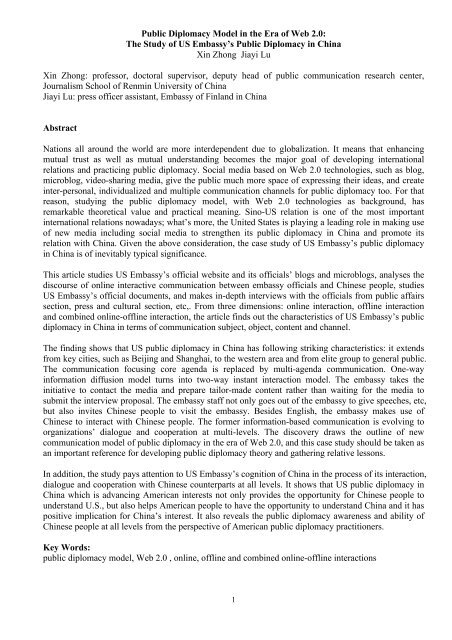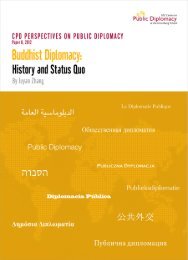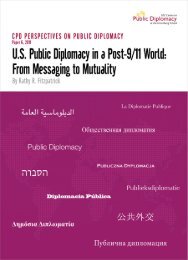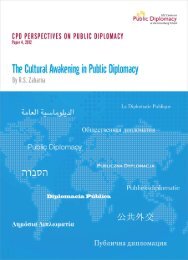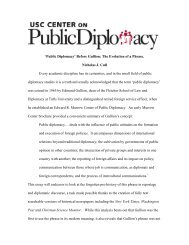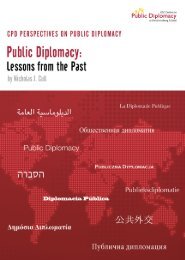Xin Zhong Jiayi Lu- Public Diplomacy Model in the Era of Web 2.0 ...
Xin Zhong Jiayi Lu- Public Diplomacy Model in the Era of Web 2.0 ...
Xin Zhong Jiayi Lu- Public Diplomacy Model in the Era of Web 2.0 ...
Create successful ePaper yourself
Turn your PDF publications into a flip-book with our unique Google optimized e-Paper software.
<strong>Public</strong> <strong>Diplomacy</strong> <strong>Model</strong> <strong>in</strong> <strong>the</strong> <strong>Era</strong> <strong>of</strong> <strong>Web</strong> <strong>2.0</strong>:<br />
The Study <strong>of</strong> US Embassy’s <strong>Public</strong> <strong>Diplomacy</strong> <strong>in</strong> Ch<strong>in</strong>a<br />
<strong>X<strong>in</strong></strong> <strong>Zhong</strong> <strong>Jiayi</strong> <strong>Lu</strong><br />
<strong>X<strong>in</strong></strong> <strong>Zhong</strong>: pr<strong>of</strong>essor, doctoral supervisor, deputy head <strong>of</strong> public communication research center,<br />
Journalism School <strong>of</strong> Renm<strong>in</strong> University <strong>of</strong> Ch<strong>in</strong>a<br />
<strong>Jiayi</strong> <strong>Lu</strong>: press <strong>of</strong>ficer assistant, Embassy <strong>of</strong> F<strong>in</strong>land <strong>in</strong> Ch<strong>in</strong>a<br />
Abstract<br />
Nations all around <strong>the</strong> world are more <strong>in</strong>terdependent due to globalization. It means that enhanc<strong>in</strong>g<br />
mutual trust as well as mutual understand<strong>in</strong>g becomes <strong>the</strong> major goal <strong>of</strong> develop<strong>in</strong>g <strong>in</strong>ternational<br />
relations and practic<strong>in</strong>g public diplomacy. Social media based on <strong>Web</strong> <strong>2.0</strong> technologies, such as blog,<br />
microblog, video-shar<strong>in</strong>g media, give <strong>the</strong> public much more space <strong>of</strong> express<strong>in</strong>g <strong>the</strong>ir ideas, and create<br />
<strong>in</strong>ter-personal, <strong>in</strong>dividualized and multiple communication channels for public diplomacy too. For that<br />
reason, study<strong>in</strong>g <strong>the</strong> public diplomacy model, with <strong>Web</strong> <strong>2.0</strong> technologies as background, has<br />
remarkable <strong>the</strong>oretical value and practical mean<strong>in</strong>g. S<strong>in</strong>o-US relation is one <strong>of</strong> <strong>the</strong> most important<br />
<strong>in</strong>ternational relations nowadays; what’s more, <strong>the</strong> United States is play<strong>in</strong>g a lead<strong>in</strong>g role <strong>in</strong> mak<strong>in</strong>g use<br />
<strong>of</strong> new media <strong>in</strong>clud<strong>in</strong>g social media to streng<strong>the</strong>n its public diplomacy <strong>in</strong> Ch<strong>in</strong>a and promote its<br />
relation with Ch<strong>in</strong>a. Given <strong>the</strong> above consideration, <strong>the</strong> case study <strong>of</strong> US Embassy’s public diplomacy<br />
<strong>in</strong> Ch<strong>in</strong>a is <strong>of</strong> <strong>in</strong>evitably typical significance.<br />
This article studies US Embassy’s <strong>of</strong>ficial website and its <strong>of</strong>ficials’ blogs and microblogs, analyses <strong>the</strong><br />
discourse <strong>of</strong> onl<strong>in</strong>e <strong>in</strong>teractive communication between embassy <strong>of</strong>ficials and Ch<strong>in</strong>ese people, studies<br />
US Embassy’s <strong>of</strong>ficial documents, and makes <strong>in</strong>-depth <strong>in</strong>terviews with <strong>the</strong> <strong>of</strong>ficials from public affairs<br />
section, press and cultural section, etc,. From three dimensions: onl<strong>in</strong>e <strong>in</strong>teraction, <strong>of</strong>fl<strong>in</strong>e <strong>in</strong>teraction<br />
and comb<strong>in</strong>ed onl<strong>in</strong>e-<strong>of</strong>fl<strong>in</strong>e <strong>in</strong>teraction, <strong>the</strong> article f<strong>in</strong>ds out <strong>the</strong> characteristics <strong>of</strong> US Embassy’s public<br />
diplomacy <strong>in</strong> Ch<strong>in</strong>a <strong>in</strong> terms <strong>of</strong> communication subject, object, content and channel.<br />
The f<strong>in</strong>d<strong>in</strong>g shows that US public diplomacy <strong>in</strong> Ch<strong>in</strong>a has follow<strong>in</strong>g strik<strong>in</strong>g characteristics: it extends<br />
from key cities, such as Beij<strong>in</strong>g and Shanghai, to <strong>the</strong> western area and from elite group to general public.<br />
The communication focus<strong>in</strong>g core agenda is replaced by multi-agenda communication. One-way<br />
<strong>in</strong>formation diffusion model turns <strong>in</strong>to two-way <strong>in</strong>stant <strong>in</strong>teraction model. The embassy takes <strong>the</strong><br />
<strong>in</strong>itiative to contact <strong>the</strong> media and prepare tailor-made content ra<strong>the</strong>r than wait<strong>in</strong>g for <strong>the</strong> media to<br />
submit <strong>the</strong> <strong>in</strong>terview proposal. The embassy staff not only goes out <strong>of</strong> <strong>the</strong> embassy to give speeches, etc,<br />
but also <strong>in</strong>vites Ch<strong>in</strong>ese people to visit <strong>the</strong> embassy. Besides English, <strong>the</strong> embassy makes use <strong>of</strong><br />
Ch<strong>in</strong>ese to <strong>in</strong>teract with Ch<strong>in</strong>ese people. The former <strong>in</strong>formation-based communication is evolv<strong>in</strong>g to<br />
organizations’ dialogue and cooperation at multi-levels. The discovery draws <strong>the</strong> outl<strong>in</strong>e <strong>of</strong> new<br />
communication model <strong>of</strong> public diplomacy <strong>in</strong> <strong>the</strong> era <strong>of</strong> <strong>Web</strong> <strong>2.0</strong>, and this case study should be taken as<br />
an important reference for develop<strong>in</strong>g public diplomacy <strong>the</strong>ory and ga<strong>the</strong>r<strong>in</strong>g relative lessons.<br />
In addition, <strong>the</strong> study pays attention to US Embassy’s cognition <strong>of</strong> Ch<strong>in</strong>a <strong>in</strong> <strong>the</strong> process <strong>of</strong> its <strong>in</strong>teraction,<br />
dialogue and cooperation with Ch<strong>in</strong>ese counterparts at all levels. It shows that US public diplomacy <strong>in</strong><br />
Ch<strong>in</strong>a which is advanc<strong>in</strong>g American <strong>in</strong>terests not only provides <strong>the</strong> opportunity for Ch<strong>in</strong>ese people to<br />
understand U.S., but also helps American people to have <strong>the</strong> opportunity to understand Ch<strong>in</strong>a and it has<br />
positive implication for Ch<strong>in</strong>a’s <strong>in</strong>terest. It also reveals <strong>the</strong> public diplomacy awareness and ability <strong>of</strong><br />
Ch<strong>in</strong>ese people at all levels from <strong>the</strong> perspective <strong>of</strong> American public diplomacy practitioners.<br />
Key Words:<br />
public diplomacy model, <strong>Web</strong> <strong>2.0</strong> , onl<strong>in</strong>e, <strong>of</strong>fl<strong>in</strong>e and comb<strong>in</strong>ed onl<strong>in</strong>e-<strong>of</strong>fl<strong>in</strong>e <strong>in</strong>teractions<br />
1
“One constant <strong>in</strong> public diplomacy has been its early adoption <strong>of</strong> new technologies, whe<strong>the</strong>r it was radio,<br />
motion pictures, high-speed pr<strong>in</strong>t<strong>in</strong>g, television or <strong>the</strong> Internet.” 1 However, technology is not self-made<br />
or exists <strong>in</strong>dependently but constructed by various social factors; meanwhile it br<strong>in</strong>gs about new<br />
communication models. S<strong>in</strong>ce <strong>the</strong> 1990s, <strong>the</strong> Internet-borderless, fast and equal-became <strong>the</strong> major<br />
communication media. Upon <strong>the</strong> 21 st century when globalization streng<strong>the</strong>ned <strong>the</strong> <strong>in</strong>ter-dependence<br />
among nations, enhanc<strong>in</strong>g mutual trust and recognition became <strong>the</strong> important target for develop<strong>in</strong>g<br />
<strong>in</strong>ternational relations and practic<strong>in</strong>g public diplomacy. Thanks to <strong>the</strong> development <strong>of</strong> <strong>the</strong> Internet,<br />
public diplomacy started to extend from <strong>the</strong> “real” platform to <strong>the</strong> “virtual” one. In particular, social<br />
media based on <strong>Web</strong> <strong>2.0</strong> technologies, such as blog and micro-blogg<strong>in</strong>g, endowed <strong>the</strong> public who are<br />
normally at <strong>the</strong> end <strong>of</strong> communication value cha<strong>in</strong> with more power to say; what’s more, it created<br />
<strong>in</strong>ter-personal, personalized and multiple communication channels for public diplomacy.<br />
S<strong>in</strong>o-US relation is one <strong>of</strong> <strong>the</strong> most important <strong>in</strong>ternational relations nowadays, and <strong>the</strong> United States is<br />
<strong>in</strong> <strong>the</strong> lead<strong>in</strong>g place <strong>in</strong> <strong>the</strong> area <strong>of</strong> streng<strong>the</strong>n<strong>in</strong>g public diplomacy by means <strong>of</strong> new media <strong>in</strong>clud<strong>in</strong>g<br />
social media. In that case, <strong>the</strong> article takes <strong>the</strong> U.S. Embassy’s public diplomacy <strong>in</strong> Ch<strong>in</strong>a under new<br />
media context as an example, explores <strong>the</strong> U.S. Embassy’s new public diplomacy model <strong>in</strong> Ch<strong>in</strong>a<br />
through macro-view topic analysis, middle-view narration analysis, micro-view source <strong>of</strong> <strong>in</strong>formation<br />
analysis and embedded communication model analysis.<br />
<strong>Public</strong> <strong>Diplomacy</strong>: New Strategy for “War <strong>of</strong> Ideas” 2 <strong>in</strong> New Media Context<br />
S<strong>in</strong>ce 9/11, American people rang<strong>in</strong>g from US president to <strong>the</strong> general public have cont<strong>in</strong>uously asked<br />
one question: “Why do <strong>the</strong>y hate us?” The United States became <strong>the</strong> only superpower s<strong>in</strong>ce <strong>the</strong> end <strong>of</strong><br />
cold war. In 1999, <strong>the</strong> United States Information Agency (USIA)-<strong>the</strong> real actor <strong>of</strong> public diplomacy<br />
dur<strong>in</strong>g <strong>the</strong> cold war-was merged <strong>in</strong>to <strong>the</strong> U.S. Department <strong>of</strong> State, and Voice <strong>of</strong> America (VOA) was<br />
subord<strong>in</strong>ated to International Broadcast<strong>in</strong>g Bureau (IBB). The explanation that American politicians<br />
gave was: do we still need <strong>the</strong>m when our enemy does not exist anymore? 9/11 attacks let US<br />
government to reconsider <strong>the</strong> importance <strong>of</strong> public diplomacy. Before long, Charlotte Beers and Karen<br />
Hughes, Under Secretary <strong>of</strong> State for <strong>Public</strong> <strong>Diplomacy</strong> and <strong>Public</strong> Affairs <strong>in</strong> Bush adm<strong>in</strong>istration,<br />
successively launched “Shared Values Campaign” <strong>in</strong> 2001 and “Middle-east Listen<strong>in</strong>g Tour” <strong>in</strong> 2005<br />
targeted at <strong>the</strong> Moslem World with <strong>the</strong> purpose <strong>of</strong> repair<strong>in</strong>g US image <strong>in</strong> <strong>the</strong> middle-east. Unfortunately,<br />
two large-scale public diplomacy activities were unsuccessfully viewed by people <strong>in</strong> <strong>the</strong> middle-east as<br />
“arrogant” “defensive”.<br />
The Internet narrowed <strong>the</strong> real distance between <strong>the</strong> United States and <strong>the</strong> middle-east, and it also<br />
endowed <strong>the</strong>m both with almost equal communication opportunities. From that po<strong>in</strong>t <strong>of</strong> view, it’s fairly<br />
normal that <strong>the</strong> public diplomacy activities with “one-way” impr<strong>in</strong>t which was popular <strong>in</strong> <strong>the</strong> cold war<br />
did not br<strong>in</strong>g about positive results. Al Jazeera English channel, one <strong>of</strong> <strong>the</strong> three biggest 24-hour<br />
English news channels <strong>in</strong> <strong>the</strong> world, reached American audience through <strong>the</strong> virtual platforms, such as<br />
YouTube, Livestation and Twitter, while before that American audience could not watch <strong>the</strong> channel<br />
s<strong>in</strong>ce “most cable and satellite carriers have apparently decided it would be politically unwise to <strong>of</strong>fer<br />
<strong>the</strong> channel” 3 In addition, state and non-state actors <strong>in</strong> <strong>the</strong> middle east started to make use <strong>of</strong> web-based<br />
platforms to set up <strong>the</strong> websites for distribut<strong>in</strong>g pan-Arabic or pan-Islamic <strong>in</strong>formation <strong>in</strong> a greater area.<br />
4 Under new media background, <strong>the</strong> traditional model <strong>of</strong> US public diplomacy is faced with challenges.<br />
In <strong>the</strong> end <strong>of</strong> 2008, James K. Glassman, <strong>the</strong>n Under Secretary <strong>of</strong> State for <strong>Public</strong> <strong>Diplomacy</strong> and <strong>Public</strong><br />
Affairs, listed <strong>the</strong> challenges that US public diplomacy was faced <strong>in</strong> <strong>the</strong> context <strong>of</strong> new media and<br />
proposed <strong>the</strong> term “<strong>Public</strong> <strong>Diplomacy</strong> <strong>2.0</strong>”: <strong>the</strong> public diplomacy that is based on <strong>Web</strong> <strong>2.0</strong> or social<br />
media technologies. He regarded it as <strong>the</strong> best way to cope with <strong>the</strong> challenges 5 and <strong>the</strong> important<br />
strategy to implement “War <strong>of</strong> Ideas” <strong>in</strong> <strong>the</strong> era <strong>of</strong> <strong>Web</strong> <strong>2.0</strong>.<br />
“Land<strong>in</strong>g” <strong>of</strong> <strong>Public</strong> <strong>Diplomacy</strong> <strong>2.0</strong>: Case Study <strong>of</strong> US Embassy’s <strong>Public</strong> <strong>Diplomacy</strong> <strong>in</strong> Ch<strong>in</strong>a<br />
2
As <strong>the</strong> real actor <strong>of</strong> US public diplomacy <strong>in</strong> Ch<strong>in</strong>a, US Embassy <strong>in</strong> Ch<strong>in</strong>a is one <strong>of</strong> <strong>the</strong> forerunners<br />
among <strong>the</strong> foreign embassies <strong>in</strong> Ch<strong>in</strong>a to make use <strong>of</strong> social media, such as blog and micro-blogg<strong>in</strong>g, to<br />
<strong>in</strong>teract with Ch<strong>in</strong>ese public. S<strong>in</strong>ce 2009, US Embassy <strong>in</strong> Ch<strong>in</strong>a launched blogs and micro-blogg<strong>in</strong>gs on<br />
two major portals <strong>in</strong> Ch<strong>in</strong>a-Tencent(qq.com) and S<strong>in</strong>a(s<strong>in</strong>a.com)-with names <strong>of</strong> “US Embassy <strong>in</strong><br />
Ch<strong>in</strong>a” “US Education Onl<strong>in</strong>e” “US Visa”, etc. The follow<strong>in</strong>g tables list US Embassy’s blogs and<br />
micro-blogg<strong>in</strong>gs:<br />
Table 1: US Embassy’s Blogs:<br />
Name <strong>of</strong> Blog Platform Launch<strong>in</strong>g Time<br />
US Embassy <strong>in</strong><br />
Ch<strong>in</strong>a<br />
Tencent<br />
S<strong>in</strong>a<br />
Nov. 12, 2009, before <strong>the</strong> first <strong>of</strong>ficial visit <strong>of</strong><br />
President Obama to Ch<strong>in</strong>a<br />
May 20, 2010, before <strong>the</strong> open<strong>in</strong>g <strong>of</strong> <strong>the</strong> Second<br />
Round <strong>of</strong> S<strong>in</strong>o-US Strategic and Economic Dialogue<br />
<strong>in</strong> Beij<strong>in</strong>g<br />
US Education<br />
Douban<br />
Sep. 28, 2010, US universities’ application season<br />
starts<br />
Onl<strong>in</strong>e<br />
S<strong>in</strong>a<br />
Sep. 28, 2010, US universities’ application season<br />
starts<br />
US Visa S<strong>in</strong>a<br />
May 8, 2009, before peak season <strong>of</strong> US visa<br />
application<br />
Henan Outreach<strong>in</strong>g<br />
Team<br />
Tencent Mar. 3, 2009<br />
Shaanxi<br />
Outreach<strong>in</strong>g Team<br />
Tencent Jul. 23, 2009<br />
Shandong<br />
Outreach<strong>in</strong>g Team<br />
Tencent Oct. 13, 2009<br />
Table 2: US Embassy’s Micro-blogg<strong>in</strong>gs:<br />
Name <strong>of</strong> Microblogg<strong>in</strong>g<br />
US Consulate General<br />
<strong>in</strong> Guangzhou<br />
Jon Huntsman’s microblogg<strong>in</strong>g<br />
Platform<br />
Twitter<br />
US Embassy <strong>in</strong> Ch<strong>in</strong>a S<strong>in</strong>a<br />
US Embassy Visa<br />
Section<br />
Tencent Apr. 7, 2010<br />
S<strong>in</strong>a<br />
From <strong>the</strong> above two tables, writer tries to conclude:<br />
Firstly, US Embassy’s blogs and micro-blogg<strong>in</strong>gs are normally named “Jon Huntsman”-<strong>the</strong> name <strong>of</strong> US<br />
Ambassador to Ch<strong>in</strong>a, and “education” and “visa” which are <strong>of</strong> Ch<strong>in</strong>ese public’s concerns. They<br />
distribute <strong>in</strong>formation to <strong>the</strong> targeted audiences <strong>in</strong> Ch<strong>in</strong>a.<br />
Secondly, <strong>the</strong> launch<strong>in</strong>g times <strong>of</strong> blogs and micro-blogg<strong>in</strong>gs are <strong>of</strong>ten right before <strong>the</strong> happen<strong>in</strong>g <strong>of</strong><br />
certa<strong>in</strong> important diplomatic events. For example, <strong>the</strong> blog at Tencent was launched <strong>in</strong> November 2009,<br />
before <strong>the</strong> first <strong>of</strong>ficial visit paid by US President Obama to Ch<strong>in</strong>a; <strong>the</strong> visa blog at S<strong>in</strong>a was launched<br />
before <strong>the</strong> peak season <strong>of</strong> US visa application.<br />
3<br />
Launch<strong>in</strong>g Time<br />
Nov. 12, 2009, before <strong>the</strong> first <strong>of</strong>ficial visit<br />
<strong>of</strong> President Obama to Ch<strong>in</strong>a<br />
May 21, 2010, before <strong>the</strong> open<strong>in</strong>g <strong>of</strong> <strong>the</strong><br />
Second Round <strong>of</strong> S<strong>in</strong>o-US Strategic and<br />
Economic Dialogue <strong>in</strong> Beij<strong>in</strong>g<br />
Jun. 11, 2010, before peak season <strong>of</strong> US<br />
visa application
First-level<br />
Topics<br />
Secondlevel<br />
Topics<br />
Texts/<br />
Percentage<br />
Thirdly, <strong>the</strong> Internet helps expand <strong>the</strong> target group <strong>of</strong> US public diplomacy <strong>in</strong> Ch<strong>in</strong>a. For <strong>in</strong>stance,<br />
outreach<strong>in</strong>g teams’ blogs realize <strong>the</strong> <strong>in</strong>teraction between <strong>the</strong> US Embassy or US Consulate Generals and<br />
Ch<strong>in</strong>ese public who are <strong>of</strong>ten overlooked due to <strong>the</strong>y are far away from <strong>the</strong> embassy or consulate<br />
generals.<br />
Fourthly, US Embassy’s blogs and micro-blogg<strong>in</strong>gs on different web-based platforms are highly<br />
overlapped <strong>in</strong> terms <strong>of</strong> content.<br />
Communication <strong>of</strong> ideas is eventually achieved through <strong>the</strong> output <strong>of</strong> textual mean<strong>in</strong>g. With <strong>the</strong> purpose<br />
<strong>of</strong> f<strong>in</strong>d<strong>in</strong>g out how <strong>the</strong> United States <strong>in</strong>teracts with Ch<strong>in</strong>ese public with ideas <strong>in</strong> <strong>the</strong> context <strong>of</strong> new<br />
media, <strong>the</strong> article analyzes US Embassy’s blog texts from three dimensions, which are macro-view<br />
topic analysis—“what to say”, middle-view narration analysis—“how to say” and micro-view source <strong>of</strong><br />
<strong>in</strong>formation analysis—“who is say<strong>in</strong>g”; what’s more, <strong>the</strong> writer tries to summarize <strong>the</strong> communication<br />
model <strong>of</strong> <strong>Public</strong> <strong>Diplomacy</strong> <strong>2.0</strong> by analyz<strong>in</strong>g <strong>the</strong> communication pattern <strong>of</strong> US Embassy’s microblogg<strong>in</strong>g.<br />
With regard to <strong>the</strong> highly overlapped contents <strong>of</strong> different blogs and micro-blogg<strong>in</strong>gs 6 , <strong>the</strong><br />
article takes <strong>the</strong> earliest US Embassy’s blog at Tencent 7 and US Ambassador Jon Huntsman’s microblogg<strong>in</strong>g<br />
at Tencent 8 as examples.<br />
Firstly, Topics—Keep<strong>in</strong>g Closer to Ch<strong>in</strong>ese <strong>Public</strong>, Highlight<strong>in</strong>g American Society, US Cultural<br />
Exchange with Ch<strong>in</strong>a and Bilateral Relations<br />
By March 31, 2011, <strong>the</strong>re are 371 texts on US Embassy’s Tencent blog. The writer tries to classify <strong>the</strong><br />
texts based on topics:<br />
Table 3: Topic List <strong>of</strong> US Embassy’s Tencent Blog:<br />
Politics<br />
Society<br />
Politics Society<br />
Life<br />
Culture<br />
People<br />
172/46.9%<br />
Bilateral<br />
Relations<br />
State<br />
Visit<br />
s<br />
55/15.0%<br />
US<br />
Ambassador’s<br />
Activities<br />
<strong>in</strong> Ch<strong>in</strong>a<br />
Economy<br />
Trade<br />
------<br />
3<br />
4<br />
Environment<br />
Energy<br />
Technology<br />
Climate<br />
Change<br />
7<br />
Social<br />
Media<br />
Cultural<br />
Exchanges<br />
with Ch<strong>in</strong>a<br />
------<br />
81/22.1%<br />
Education<br />
Visa<br />
Educa<br />
-tion,<br />
Study<br />
<strong>in</strong> US<br />
The table above shows that <strong>the</strong> first-level topics-“Politics and Society” “Cultural Exchanges with<br />
Ch<strong>in</strong>a” and “Bilateral Relations”-are among <strong>the</strong> top three, which means <strong>in</strong>troduc<strong>in</strong>g American society,<br />
cultural exchanges with Ch<strong>in</strong>a as well as S<strong>in</strong>o-US bilateral relations are <strong>the</strong> core agenda <strong>of</strong> US public<br />
diplomacy <strong>in</strong> Ch<strong>in</strong>a. The writer tries to segment <strong>the</strong> topic “Politics and Society” <strong>in</strong>to second-level topics<br />
and f<strong>in</strong>ds out that <strong>the</strong> texts about “Society, Life, Culture and People” are 167, account<strong>in</strong>g for 97%, and<br />
<strong>the</strong> number <strong>of</strong> <strong>the</strong> texts under much smaller topics, such as “Revenue and Consumption” “Social<br />
Security” is more than that under <strong>the</strong> serious topic <strong>of</strong> “US Politics”, which exhibits that US Embassy<br />
tends to narrow <strong>the</strong> psychological distance with Ch<strong>in</strong>ese public by display<strong>in</strong>g <strong>the</strong> pictures <strong>of</strong> ord<strong>in</strong>ary<br />
American people’s lives.<br />
Picture 1: Blogs about “Revenue and Consumption” and “Society Security”:<br />
13<br />
Visa<br />
Poli<br />
-cy<br />
Oth<br />
ers<br />
-----<br />
40
Revenue &<br />
Consumption<br />
Social Security<br />
“Cultural Exchanges with<br />
Ch<strong>in</strong>a” is one dimension <strong>of</strong> traditional US public diplomacy <strong>in</strong> Ch<strong>in</strong>a. In <strong>the</strong> past, cultural exchanges<br />
were generally achieved by face-to-face <strong>in</strong>ter-personal <strong>in</strong>teraction. The blog technology gives US<br />
Embassy a new tool to implement public diplomacy: <strong>in</strong>form<strong>in</strong>g Ch<strong>in</strong>ese public <strong>of</strong> latest cultural and<br />
artistic events organized by <strong>the</strong> embassy, <strong>in</strong>teract<strong>in</strong>g with Ch<strong>in</strong>ese netizens virtually, etc.<br />
“Bilateral Relations” is one <strong>of</strong> <strong>the</strong> core responsibilities undertaken by diplomatic missions overseas.<br />
Traditional media are more <strong>in</strong>cl<strong>in</strong>ed to cover<strong>in</strong>g <strong>the</strong> topic from <strong>the</strong> perspective <strong>of</strong> politics; whereas new<br />
media tend to keep closer to ord<strong>in</strong>ary people <strong>in</strong> Ch<strong>in</strong>a. For <strong>in</strong>stance, under <strong>the</strong> second-level topic <strong>of</strong><br />
“State Visits”, US Embassy’s Tencent blog <strong>in</strong>troduces several detailed <strong>in</strong>formation that ord<strong>in</strong>ary people<br />
may feel <strong>in</strong>terested, such as who are <strong>the</strong> guests <strong>in</strong>vited, what is <strong>the</strong> menu <strong>of</strong> state banquet.<br />
Secondly, Narration—Focus<strong>in</strong>g on <strong>the</strong> Interests <strong>of</strong> Ch<strong>in</strong>ese <strong>Public</strong>, Reflect<strong>in</strong>g Op<strong>in</strong>ions through<br />
Narration<br />
The first-level topics can be segmented <strong>in</strong>to smaller topics which are closer to <strong>the</strong> general public, yet<br />
how does <strong>the</strong> blog text narrate so as to reflect <strong>the</strong> ideas? The article takes 4 blog texts that are under <strong>the</strong><br />
second-level topics <strong>of</strong> “Society, Life, Culture and People” as example, and tries to analyze its narration<br />
frame.<br />
Table 4: Blog Texts under “Hous<strong>in</strong>g Price”:<br />
American Family’s Electricity Bill<br />
American Family’s Water Bill<br />
Customers Love Cheap Goods, One-dollar Shops Popular<br />
American Family’s Telephone/Cable TV/Broad-band Bills<br />
American Citizen’s Monthly Cost <strong>of</strong> Mobile Phone<br />
American Family’s Revenue and Expense: Revenue<br />
American Family’s Revenue and Expense: Expense<br />
Why <strong>the</strong> Management Fee <strong>of</strong> Cooperative Apartment <strong>in</strong> New<br />
York is So High: Answers to Netizens’ Questions<br />
How Much Cost Buy<strong>in</strong>g House <strong>in</strong> US?<br />
Rental <strong>in</strong> US<br />
Hous<strong>in</strong>g Price <strong>in</strong> US<br />
Foreigners are Interested <strong>in</strong> American Real Estate Market, As<br />
Same as that <strong>in</strong> Ch<strong>in</strong>a<br />
Emergency and Aid and Medical Insurance for All People <strong>in</strong> US<br />
American Senior Citizens’ Right to Work<br />
People from Lower Social Class <strong>in</strong> US: Foreign Students and<br />
American Senior Citizens <strong>of</strong> Ch<strong>in</strong>ese Orig<strong>in</strong><br />
People from Lower Social Class <strong>in</strong> US: Servants at Restaurant<br />
Time Headl<strong>in</strong>e Author View/Comment<br />
Jan. 5, 2011 How Much Cost Buy<strong>in</strong>g House <strong>in</strong> US? Jianan, Ch<strong>in</strong>ese <strong>in</strong> US 17912/440<br />
Jan. 10, 2011 Rental <strong>in</strong> US Jianan, Ch<strong>in</strong>ese <strong>in</strong> US 168717/182<br />
Jan. 11, 2011 Hous<strong>in</strong>g Price <strong>in</strong> US Jianan, Ch<strong>in</strong>ese <strong>in</strong> US 29074/88<br />
Jan. 18, 2011 Foreigners are Interested <strong>in</strong> American Real<br />
Estate Market, As Same as that <strong>in</strong> Ch<strong>in</strong>a<br />
Xiao, Ch<strong>in</strong>ese <strong>in</strong> US 364/6<br />
5
Picture 2: Narration Frame <strong>of</strong> Blog Texts under “Hous<strong>in</strong>g Price”:<br />
Hous<strong>in</strong>g price <strong>in</strong>creases quickly <strong>in</strong> Ch<strong>in</strong>a, and it becomes <strong>the</strong><br />
topic <strong>of</strong> Ch<strong>in</strong>ese public’s largest concern<br />
“Hous<strong>in</strong>g Price” became <strong>the</strong> hottest topic among Ch<strong>in</strong>ese public recently, which is proved by <strong>the</strong><br />
statistics <strong>of</strong> View/Comment shown above. From <strong>the</strong> narration analysis, 4 blog texts grasp <strong>the</strong> po<strong>in</strong>ts-for<br />
<strong>in</strong>stance, hous<strong>in</strong>g price-that Ch<strong>in</strong>ese public feel most <strong>in</strong>terested and answer <strong>the</strong> questions raised through<br />
virtual <strong>in</strong>teraction. At <strong>the</strong> same time, a comprehensive picture <strong>of</strong> hous<strong>in</strong>g rent, hous<strong>in</strong>g price as well as<br />
<strong>the</strong> real estate market <strong>in</strong> US is shown to Ch<strong>in</strong>ese public, and <strong>the</strong> op<strong>in</strong>ions-<strong>the</strong> ratio <strong>of</strong> revenue and cost<br />
with respect to hous<strong>in</strong>g price <strong>in</strong> US is reasonable; real estate market <strong>in</strong> US is <strong>of</strong> <strong>in</strong>vestment value-are<br />
reflected through narrat<strong>in</strong>g.<br />
However, one po<strong>in</strong>t needs to be mentioned is that <strong>the</strong> <strong>in</strong>tention <strong>of</strong> <strong>the</strong> author is doubted by netizens and<br />
<strong>the</strong> author adds “As Same as that <strong>in</strong> Ch<strong>in</strong>a” <strong>in</strong>to <strong>the</strong> headl<strong>in</strong>e <strong>of</strong> <strong>the</strong> fourth blog text <strong>in</strong> order to be more<br />
balanced, yet little mentioned concern<strong>in</strong>g Ch<strong>in</strong>a’s real estate market <strong>in</strong> <strong>the</strong> article.<br />
Thirdly, Sources—Highlight<strong>in</strong>g <strong>the</strong> Voices from “Ch<strong>in</strong>ese <strong>in</strong> US” and “US diplomat <strong>in</strong> Ch<strong>in</strong>a”,<br />
More Persuasive and Genial<br />
Besides reflected through narration, op<strong>in</strong>ions can also be shown through different sources <strong>of</strong><br />
<strong>in</strong>formation.<br />
Picture 3: Sources <strong>of</strong> Blog Texts:<br />
Organization and People <strong>in</strong> US Organization and People <strong>in</strong> Ch<strong>in</strong>a Media from Ch<strong>in</strong>a O<strong>the</strong>rs<br />
Picture 4: Quantity <strong>of</strong> Different Sources:<br />
The real situation <strong>of</strong> buy<strong>in</strong>g houses <strong>in</strong> US<br />
Netizens ask <strong>the</strong> questions about rent<strong>in</strong>g apartment <strong>in</strong> US, <strong>the</strong> author <strong>in</strong>troduces<br />
<strong>the</strong> situation <strong>of</strong> rent<strong>in</strong>g apartment <strong>in</strong> US<br />
Netizens ask <strong>the</strong> questions about hous<strong>in</strong>g price <strong>in</strong> US, <strong>the</strong> author <strong>in</strong>troduces<br />
<strong>the</strong> hous<strong>in</strong>g price <strong>in</strong> US <strong>in</strong> a comprehensive way<br />
Netizens raise doubts about <strong>the</strong> author’s <strong>in</strong>tentions, and <strong>the</strong> author clarifies that <strong>in</strong>troduc<strong>in</strong>g hous<strong>in</strong>g<br />
price <strong>in</strong> US is with no o<strong>the</strong>r <strong>in</strong>tentions, claim<strong>in</strong>g that “this is my personal op<strong>in</strong>ion”<br />
International Person Media Official Commercial<br />
Information<br />
Bureau<br />
US<br />
Embassy<br />
<strong>in</strong> Ch<strong>in</strong>a<br />
Person<br />
US Citizen Ch<strong>in</strong>ese <strong>in</strong> US Diplomat US Student <strong>in</strong> Ch<strong>in</strong>a<br />
6
Accord<strong>in</strong>g to picture 3 and 4, three largest sources are “US Embassy <strong>in</strong> Ch<strong>in</strong>a” “Ch<strong>in</strong>ese <strong>in</strong> US” and<br />
“US Diplomat <strong>in</strong> Ch<strong>in</strong>a”, account<strong>in</strong>g for 75% <strong>of</strong> <strong>the</strong> total.<br />
Generally speak<strong>in</strong>g, foreign embassies <strong>in</strong> Ch<strong>in</strong>a are <strong>the</strong> authoritative source <strong>of</strong> <strong>in</strong>formation concern<strong>in</strong>g<br />
foreign nations <strong>in</strong> Ch<strong>in</strong>a. The blog technology gives “Ch<strong>in</strong>ese <strong>in</strong> US” and “US Diplomat <strong>in</strong> Ch<strong>in</strong>a”<br />
much more opportunities to say, and <strong>the</strong>ir voices have two strengths: one is to take <strong>the</strong> advantage <strong>of</strong><br />
<strong>the</strong>ir Ch<strong>in</strong>ese language skills <strong>in</strong> order to avoid misunderstand<strong>in</strong>g caused by language differences and <strong>the</strong><br />
o<strong>the</strong>r is that personal voices are more persuasive and genial. Never<strong>the</strong>less, <strong>the</strong> function <strong>of</strong> mak<strong>in</strong>g use <strong>of</strong><br />
blog texts written by Ch<strong>in</strong>ese <strong>in</strong> US needs fur<strong>the</strong>r consideration s<strong>in</strong>ce <strong>the</strong> <strong>in</strong>tentions <strong>of</strong> <strong>the</strong> author might<br />
be doubted, as discussed above.<br />
Fourthly, “Embedded” <strong>Public</strong> <strong>Diplomacy</strong> Created by Micro-blogg<strong>in</strong>g<br />
Blog platform helps <strong>the</strong> public who are normally at <strong>the</strong> end <strong>of</strong> communication value cha<strong>in</strong> to move to<br />
<strong>the</strong> front and with that tool, US public diplomacy <strong>in</strong> Ch<strong>in</strong>a seems more segmented, personalized and<br />
genial. Micro-blogg<strong>in</strong>g, which can distribute short messages through both wireless and wire-based<br />
channel and shuttle among different social networks swiftly, creates “embedded” public diplomacy 9 .<br />
Based on <strong>the</strong> analysis <strong>of</strong> US Embassy’s Tencent micro-blogg<strong>in</strong>g, <strong>the</strong> writer tries to conclude <strong>the</strong> model<br />
<strong>of</strong> “embedded” public diplomacy as follows:<br />
1, Communication on <strong>the</strong> basis <strong>of</strong> “personal brand”<br />
“Distribution <strong>of</strong> micro-blogg<strong>in</strong>g contents is based on ‘follow<strong>in</strong>g’ ‘follower’ among micro-bloggers.” 10<br />
The importance <strong>of</strong> <strong>in</strong>ter-personal trust is highlighted <strong>in</strong> micro-blogg<strong>in</strong>g communication, and <strong>the</strong> node<br />
with high credibility is much easier to exert <strong>in</strong>fluence <strong>in</strong> <strong>the</strong> social network. Foreign ambassador to<br />
Ch<strong>in</strong>a, who is <strong>the</strong> highest figure represented foreign nation <strong>in</strong> Ch<strong>in</strong>a, is generally viewed by Ch<strong>in</strong>ese<br />
public as <strong>the</strong> person obta<strong>in</strong>s higher credibility. Social media provides foreign ambassadors opportunities<br />
to walk from <strong>the</strong> backstage to <strong>the</strong> stage and <strong>the</strong>ir personal brands become important nodes <strong>in</strong> microblogg<strong>in</strong>g<br />
communication to attract <strong>the</strong> general public. For <strong>in</strong>stance, <strong>the</strong> first micro-blogg<strong>in</strong>g launched by<br />
US Embassy <strong>in</strong> Ch<strong>in</strong>a is <strong>the</strong> one named “Jon Huntsman”-<strong>the</strong> name <strong>of</strong> US Ambassador to Ch<strong>in</strong>a. It is<br />
managed centered on his personal brand-“<strong>the</strong> first US Ambassador to Ch<strong>in</strong>a arrived <strong>in</strong> Lhasa s<strong>in</strong>ce<br />
2002” “US Ambassador to Ch<strong>in</strong>a and his wife take <strong>the</strong>ir Ch<strong>in</strong>ese daughter to her birth place Yangzhou”<br />
“US Ambassador to Ch<strong>in</strong>a goes grocery shopp<strong>in</strong>g by bicycle”, etc. Many texts about Jon Huntsman<br />
become hot nodes to be rebroadcast or commented, for <strong>in</strong>stance, <strong>the</strong> text “US Ambassador to Ch<strong>in</strong>a<br />
goes grocery shopp<strong>in</strong>g by bicycle” attracts 1562 netizens to rebroadcast or comment.<br />
2, Real-time Communication<br />
Although <strong>the</strong> content <strong>of</strong> micro-blogg<strong>in</strong>g is limited with<strong>in</strong> 140 characters and thus it cannot convey<br />
op<strong>in</strong>ions through narration as what blog does, it can distribute <strong>in</strong>formation on multiple term<strong>in</strong>als<br />
flexibly so as to achieve real-time public diplomacy. For <strong>in</strong>stance, on <strong>the</strong> morn<strong>in</strong>g <strong>of</strong> May 21 st , 2010,<br />
7
Gary Locke-US Commerce Secretary who came to Ch<strong>in</strong>a to attend <strong>the</strong> Second Round <strong>of</strong> S<strong>in</strong>o-US<br />
Strategic and Economic Dialogue <strong>in</strong> Beij<strong>in</strong>g-was go<strong>in</strong>g to give a speech at Ts<strong>in</strong>ghua University, US<br />
Embassy <strong>in</strong> Ch<strong>in</strong>a distributed <strong>the</strong> first micro-blogg<strong>in</strong>g at 08:36, and dur<strong>in</strong>g <strong>the</strong> whole process, it utilized<br />
<strong>the</strong> micro-blogg<strong>in</strong>g to “live broadcast” <strong>the</strong> speech and <strong>in</strong>teract with <strong>the</strong> people who were not present by<br />
virtual means.<br />
3, Integrat<strong>in</strong>g <strong>Public</strong> <strong>Diplomacy</strong> Resources<br />
“Driv<strong>in</strong>g force <strong>of</strong> micro-blogg<strong>in</strong>g’ impact is orig<strong>in</strong>ated from collaborative content production <strong>in</strong>spired<br />
by its role as <strong>in</strong>formation service platform as well as <strong>in</strong>formation circuit based on users’ social networks.<br />
Its essence lies <strong>in</strong> <strong>in</strong>tegrat<strong>in</strong>g <strong>in</strong>formation resources.” 11 US Embassy’s micro-blogg<strong>in</strong>g helps <strong>in</strong>tegrate<br />
virtual public diplomacy resources by means <strong>of</strong> “micro-blogg<strong>in</strong>g text + l<strong>in</strong>k”, and takes <strong>the</strong> advantage<br />
<strong>of</strong> both on-l<strong>in</strong>e and <strong>of</strong>f-l<strong>in</strong>e public diplomacy resources. For <strong>in</strong>stance, US Embassy releases <strong>the</strong> latest<br />
<strong>in</strong>formation about <strong>of</strong>f-l<strong>in</strong>e cultural activities and <strong>in</strong>vites micro-bloggers to w<strong>in</strong> entrance tickets by<br />
answer<strong>in</strong>g on-l<strong>in</strong>e questions.<br />
Conclusion<br />
Based on <strong>the</strong> above analysis, <strong>the</strong> writer tries to conclude <strong>the</strong> characteristics <strong>of</strong> US <strong>Public</strong> <strong>Diplomacy</strong> <strong>2.0</strong><br />
as:<br />
Firstly, US Embassy <strong>in</strong> Ch<strong>in</strong>a-<strong>the</strong> traditional communication subject-has gradually converted from real<br />
actor to chief designer and platform provider. It organizes <strong>the</strong> virtual public diplomacy resources,<br />
express<strong>in</strong>g ideas through segment<strong>in</strong>g topics, sett<strong>in</strong>g up narration frame and select<strong>in</strong>g sources <strong>of</strong><br />
<strong>in</strong>formation.<br />
Secondly, <strong>in</strong> view <strong>of</strong> communication object, virtual space helps US Embassy or Consulate Generals <strong>in</strong><br />
Ch<strong>in</strong>a to reach <strong>the</strong> western areas and Ch<strong>in</strong>ese public who are normally overlooked by traditional public<br />
diplomacy with “on-l<strong>in</strong>e outreach<strong>in</strong>g teams”. Meanwhile, <strong>the</strong> communication object that is normally at<br />
<strong>the</strong> end <strong>of</strong> communication value cha<strong>in</strong> is given more opportunities to say.<br />
Thirdly, <strong>the</strong> Internet gives public diplomacy much more communication channels, and <strong>the</strong> topics which<br />
previously were not be shown thoroughly can be expressed <strong>in</strong> a more personalized and genial manner.<br />
Fourthly, social media based on <strong>Web</strong> <strong>2.0</strong> technologies help public diplomacy break through <strong>the</strong><br />
traditional limitations <strong>in</strong> time and space, achiev<strong>in</strong>g communication on multiple platforms. In particular,<br />
micro-blogg<strong>in</strong>g with “embedded” characteristics helps realize <strong>the</strong> real-time public diplomacy.<br />
All <strong>the</strong>se might be concluded with what Judith McHale, Under Secretary <strong>of</strong> State for <strong>Public</strong> <strong>Diplomacy</strong><br />
and <strong>Public</strong> Affairs <strong>in</strong> Obama Adm<strong>in</strong>istration once said “move from an old paradigm, <strong>in</strong> which our<br />
government speaks as one to many, to a new model <strong>of</strong> engag<strong>in</strong>g <strong>in</strong>teractively and collaboratively across<br />
l<strong>in</strong>es that might o<strong>the</strong>rwise divide us from people around <strong>the</strong> world” 12 .<br />
Draw<strong>in</strong>g from <strong>the</strong> case study shown above, more questions need fur<strong>the</strong>r research:<br />
Firstly, blog and micro-blogg<strong>in</strong>g platforms are ma<strong>in</strong>ly used to <strong>in</strong>form <strong>the</strong> public <strong>of</strong> “what I’m do<strong>in</strong>g” at<br />
current stage, and <strong>the</strong>re is still a long way to go to <strong>in</strong>form <strong>the</strong> public <strong>of</strong> “what I’m th<strong>in</strong>k<strong>in</strong>g”, and <strong>the</strong><br />
latter is actually <strong>the</strong> key po<strong>in</strong>t <strong>of</strong> “War <strong>of</strong> Ideas”. As for how to make use <strong>of</strong> <strong>the</strong> voices from Ch<strong>in</strong>ese <strong>in</strong><br />
US and Ch<strong>in</strong>ese media so as to express ideas, it also deserves fur<strong>the</strong>r study.<br />
Secondly, social media enhance <strong>the</strong> <strong>in</strong>teraction between communication subject and object, yet <strong>the</strong> case<br />
study shows that on-l<strong>in</strong>e <strong>in</strong>teraction at current stage is still conf<strong>in</strong>ed to <strong>the</strong> model <strong>of</strong> “comment-reply”.<br />
Whe<strong>the</strong>r <strong>the</strong> voices from <strong>the</strong> public “heard” and is <strong>the</strong>re any feedback after be<strong>in</strong>g “heard” still need to<br />
be explored.<br />
Thirdly, social media can help display <strong>the</strong> same public diplomacy resource on different platforms, but <strong>in</strong><br />
light <strong>of</strong> <strong>the</strong> importance <strong>of</strong> personal brand to micro-blogg<strong>in</strong>g communication, how to <strong>in</strong>tegrate and<br />
distribute <strong>in</strong>formation based on respective characteristics <strong>of</strong> blog and micro-blogg<strong>in</strong>g is <strong>the</strong> key po<strong>in</strong>t <strong>in</strong><br />
<strong>the</strong> future research.<br />
1 Barry Fulton, The Uses <strong>of</strong> Modern Technology <strong>in</strong> <strong>Public</strong> <strong>Diplomacy</strong>, Engag<strong>in</strong>g <strong>the</strong> Arab & Islamic<br />
8
Worlds through <strong>Public</strong> <strong>Diplomacy</strong>: A Report and Action Recommendation, p 23<br />
2 James K. Glassman, Former Under Secretary <strong>of</strong> State for <strong>Public</strong> <strong>Diplomacy</strong> and <strong>Public</strong> Affairs, once<br />
mentioned <strong>in</strong> a speech <strong>in</strong> 2008 that <strong>the</strong> United States was adept <strong>in</strong> “War <strong>of</strong> Ideas” dur<strong>in</strong>g <strong>the</strong> cold war,<br />
but s<strong>in</strong>ce <strong>the</strong> collapse <strong>of</strong> Berl<strong>in</strong> wall, “War <strong>of</strong> Ideas” stepped down. 9/11 attacks <strong>in</strong> 2001 let Bush<br />
adm<strong>in</strong>istration recognized <strong>the</strong> importance <strong>of</strong> “War <strong>of</strong> Ideas” aga<strong>in</strong>.<br />
3 Philip Seib, Transnational Journalism, <strong>Public</strong> <strong>Diplomacy</strong>, and Virtual States, p12, see:<br />
http://uscpublicdiplomacy.org/Melbourne%202009%20paper.pdf<br />
4 See Philip Seib, Transnational Journalism, <strong>Public</strong> <strong>Diplomacy</strong>, and Virtual States,<br />
http://uscpublicdiplomacy.org/Melbourne%202009%20paper.pdf<br />
5 See James K. Glassman, <strong>Public</strong> <strong>Diplomacy</strong> <strong>2.0</strong>: A New Approach to Global Engagement,<br />
http://merln.ndu.edu/archivepdf/nss/state/112605.pdf<br />
6 The writer selects <strong>the</strong> contents <strong>of</strong> US Embassy’s blogs at Tencent and S<strong>in</strong>a, micro-blogg<strong>in</strong>gs at<br />
Tencent and S<strong>in</strong>a from June 1 to December 31, 2010 as <strong>the</strong> sample pool, and pick out <strong>the</strong> texts on 5 th ,<br />
10 th , 15 th , 20 th , 25 th and 30 th every month: 25 texts on Tencent and S<strong>in</strong>a blogs respectively, 100%<br />
matches toge<strong>the</strong>r; 99 texts and 102 texts on Tencent micro-blogg<strong>in</strong>g and S<strong>in</strong>a micro-blogg<strong>in</strong>g<br />
respectively, 95 texts match toge<strong>the</strong>r.<br />
7 See: http://user.qzone.qq.com/622008844<br />
8 See: http://t.qq.com/USEmbassy<br />
9 This term is <strong>in</strong>spired by <strong>the</strong> article Micro-blogg<strong>in</strong>g: From Embed-Suit Mechanism to Pr<strong>of</strong>it <strong>Model</strong> by<br />
Yu Guom<strong>in</strong>g<br />
10 Kai-fu Lee, Micro-blogg<strong>in</strong>g Changes Everyth<strong>in</strong>g: Shanghai University <strong>of</strong> F<strong>in</strong>ance and Economics<br />
Press, 2011, p 60<br />
11 Yu Guom<strong>in</strong>g, Micro-blogg<strong>in</strong>g: From Embed-Suit Mechanism to Pr<strong>of</strong>it <strong>Model</strong><br />
See http://qnjz.dzwww.com/qybg/201008/t20100811_5761018.htm<br />
12 See Helle C. Dale, <strong>Public</strong> <strong>Diplomacy</strong> <strong>2.0</strong>: Where <strong>the</strong> U.S. Government Meets “New Media”,<br />
http://orig<strong>in</strong>.heritage.org/Research/Reports/2009/12/<strong>Public</strong>-<strong>Diplomacy</strong>-2-0-Where-<strong>the</strong>-US-<br />
Government-Meets-New-Media<br />
9


